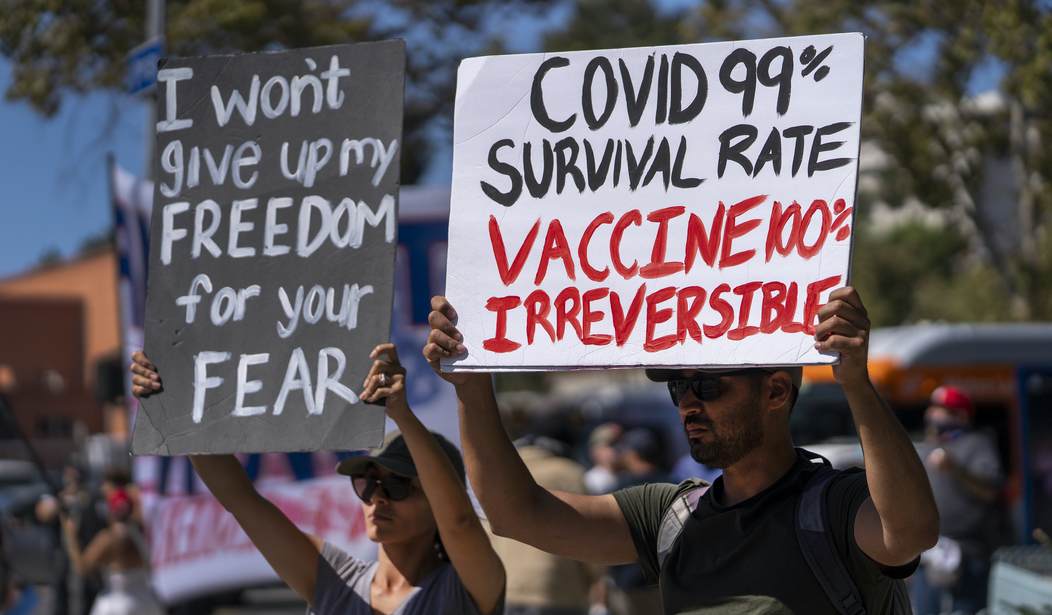“Crazy” doesn’t mean “unexpected.” To the contrary, polls showing that the vaccinated are more likely than the unvaxxed to continue taking precautions despite their greater protection from the virus have been around almost as long as the vaccines have.
Which, on one level, is intuitive. If you’re more willing to take risks with COVID, you’re probably less likely to hedge against risk by getting vaccinated — and vice versa. As a gloss on risk-tolerance, the poll findings aren’t surprising.
But as a demonstration of how little the vaccines have convinced the vaccinated to reclaim some of the normalcy they supposedly crave, they never fail to shock.
This new one from Morning Consult and the Times’s David Leonhardt is extra shocking because it doesn’t just measure behavior, it measures anxiety. It’s one thing for a boosted person to continue to mask up and isolate indefinitely, as doing so may spare them from a week of illness even though they’re protected from severe disease. But it’s another thing for the boosted to worry more than the unvaccinated do about getting sick. Especially now that more dangerous variants have been mostly supplanted by a less dangerous one in Omicron.
A sign of our national irrationality about Covid: Unvaccinated people are less worried about Covid sickness than vaccinated people. And vaccinated people are less worried than boosted people. pic.twitter.com/G4KMDvyqqA
— David Leonhardt (@DLeonhardt) January 25, 2022
Last year when polls gauging the difference in attitudes between the vaxxed and unvaxxed first appeared, I thought they demonstrated the ignorance of the latter more than the former. After all, it wasn’t crazy for the vaccinated to want to wait and see how well the vaccines held up in the real world before throwing caution to the wind and resuming full normalcy. And it was crazy for the unvaccinated to proceed with full normalcy once the data began to show how much higher the death rate was within their cohort than it was among the vaccinated.
But a year later, the picture looks different. With Omicron now ubiquitous, tons more natural immunity in the population, new therapeutics available, and plenty of data showing how well boosters work to prevent severe illness, the fact that the boosted remain more worried about sickness than the unvaccinated are is evidence of their hypercaution more so than the other group’s incaution. Although there’s still lots of irrationality in both groups, Damon Linker points out: The vaxxed seem to believe on some level that the vaccines don’t really work while the unvaxxed believe they have more to fear from vaccination than from a killer disease.
Risk-tolerance only partly explains what’s happening here, however. Leonhardt’s data also shows that a larger share of adults aged 18-34 are “very worried” about getting COVID than senior citizens are despite the fact that young adults are at basically no risk of a bad outcome. And there’s an enormous partisan gap, with 65 percent of Dems saying they’re willing to make changes to their normal activity to prioritize safety and public health versus just 30 percent of Republicans. The age gap is probably a function of the partisan gap, Leonhardt notes, since older adults trend right while younger adults trend left. And how you feel about COVID is very much a matter of tribal identity in America 2022.
Millions of Republican voters have decided that downplaying Covid is core to their identity as conservatives, even as their skepticism of vaccines means that the virus is killing many more Republicans than Democrats.
Millions of Democrats have decided that organizing their lives around Covid is core to their identity as progressives, even as pandemic isolation and disruption are fueling mental-health problems, drug overdoses, violent crime, rising blood pressure and growing educational inequality. As David Hogg, a gun-control activist, tweeted last year, “The inconvenience of having to wear a mask is more than worth it to have people not think I’m a conservative.”
Partisan identity is the engine of this, I agree, and it also has knock-on effects by influencing what sort of media each side consumes. If you’re a Republican, you’re more likely to be watching or reading things that claim COVID is overblown. If you’re a Democrat, you’re more likely to be watching or reading things that exaggerate the risks from COVID. These numbers among Dems are some of the grimmest data I’ve seen during the pandemic, illustrating how out of whack liberals’ anxiety about COVID sickening their kids is relative to the threat:
Many Democrats are effectively dismissing these costs and instead focusing on the minuscule Covid risks for children. Most Democrats say they favor moving classes online in response to Omicron, despite widespread evidence that remote school has failed. pic.twitter.com/xtPpS1WJji
— David Leonhardt (@DLeonhardt) January 25, 2022
Leonhardt has been on a mission lately to try to get it through the thick heads of his left-leaning audience that their children are at practically no risk whatsoever of a dire bout with COVID. And I think the reason he’s on that mission is because he realizes how few opinion-shapers in his cultural niche are confronting parents with the data despite what we’re learning about how damaging it is for kids to be out of school long-term. Liberal parents have been effectively brainwashed at this point into believing that their children being in class is a threat meaningfully greater than the flu even though it isn’t — and isn’t meaningfully greater for parents either, provided that they’re boosted and otherwise healthy. He’s trying to singlehandedly deprogram the hypercautious Times readership. Godspeed.








